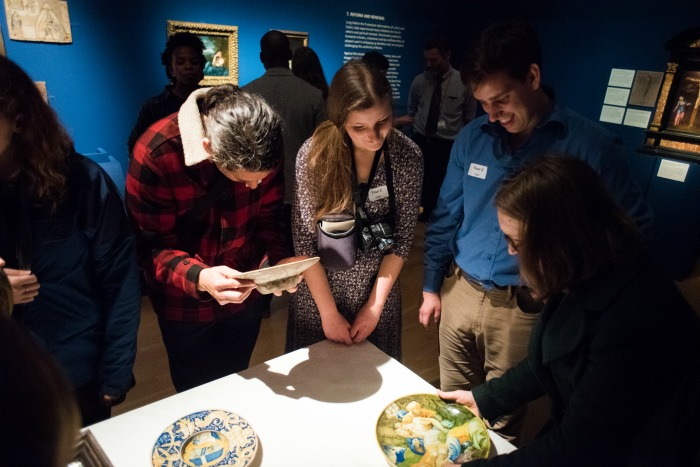James McMullen spent the summer at the Fitzwilliam Museum as part of his University of Leicester work placement. Working with a team of volunteers, he surveyed over 500 visitors to the Fitzwilliam and got feedback on their experiences. The answers he got were surprising, and gave a great foundation to build on for future development of the visitor experience. James writes…
My work placement from the University of Leicester started off with a request to set up some evaluations of the way visitors perceived the Fitzwilliam Museum and get feedback for suggested improvements to the museum and overall visitor experience. After consulting with Head of Learning Miranda Stearn, and hashing out some ideas as to how to most accurately and effectively collect the data, I decided on using a combination of paper and online surveys to get visitor feedback, as well as giving respondents an option for an in-depth interview.
Once I had my plans and questions approved, I got things in order for the surveying, then put everything onto the backburner while I helped out with Family Art Week and Fitz Family Firsts. Once things calmed down (somewhat – there’s no end of work when you’re part of the public-facing team at a museum!) we got down to the business of surveying and getting feedback from our visitors.
Collecting data
I worked alongside two excellent volunteers – Corinne Garvie and Lekha Choksi – during the three weeks I collected data, and we made some really astounding numbers. Over nine days of surveying at the Founder’s Entrance, we collected 228 survey responses from a total of 522 visitors. Over 150 of those were collected by Corinne and Lekha, whose help was absolutely essential, and allowed me to give attention to other projects with the Learning team, as well as help out with projects at other UCM museums.
One of the biggest challenges we faced when collecting data was the online component. Despite getting almost 100 email addresses, only six people responded to our request to take a follow-up online survey, which was unfortunately not anywhere near enough to make an accurate assessment. This did leave a bit of a gap in the data, but nothing insurmountable, as Corrinne and Lekha did a fantastic job of getting responses.
Once the data had been collected, I organised it into a spreadsheet for quick viewing of the information and then began an analysis of the results.
The results
The results we received from the public were, in some ways, very surprising. Overall, the visitors we surveyed (over 500 in the course of 9 days!) were extremely satisfied with their visit to the Fitzwilliam, with over 90% rating their visit a 4-out-of-5 or higher, but did have a number of suggestions to improve the museum experience as a whole.
Regardless of how they rated their experience at the Fitzwilliam, the feedback from visitors indicated that there’s a desire for more interactive elements to the exhibits, and a change in the way that the objects are interpreted and presented. The requests for more interactive elements came from visitors across a wide spectrum of ages, which runs counter to some of the more accepted wisdom in the sector that interactives are only really wanted by younger visitors. Even if that were the case, young visitors are our future, and we should be listening to what they want in order to make sure that they keep on coming to the museum as they get older.

What’s next?
The obvious course of action – at least based on the frequency of the feedback we received – would be to work on how we can increase the interactivity in our exhibitions and review the interpretation of the objects in the museum. There are a number of ways which the museum can work on getting visitors to interact with the exhibits, and in ways which won’t involve any risk to the objects either.
Object handling using replicas would be a relatively easy and inexpensive way to allow audiences to interact with the museum. There’s very little risk involved in allowing visitors to dress up in replica armour or reproductions of period-appropriate dresses and coats, for example, and it allows visitors to more fully appreciate the realities of some of the objects they will encounter in the museum. Additionally, tactile displays of materials that make up objects – especially the wooden furnishings and instruments across the museum – would give visitors the chance to see what the objects are like without risking any damage.
Interpretation can be a bit trickier to tackle, as it requires rewriting labelling or adding new, detailed labels to existing displays. While we have a number of excellent interpretation panels throughout the museum – especially in the Greek and Roman, Egyptian, and Ancient Near East galleries – there is always the opportunity to add more elsewhere. More interpretation will allow visitors – the vast majority of whom are not experts in all subjects presented at the museum – to get a greater appreciation of the objects we have on display, and will help to encourage repeat visits by making the exhibits more understandable and, simultaneously, more intimate.







